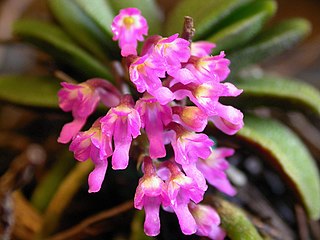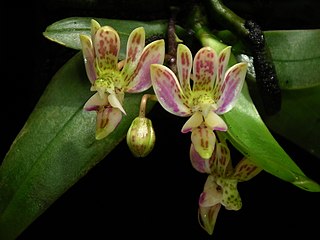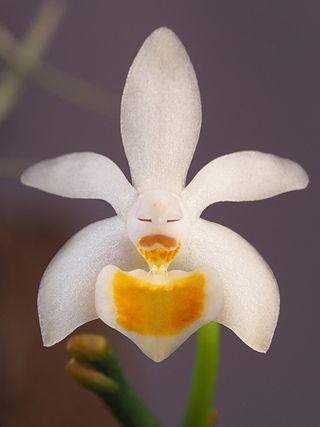
Dendrobium is a genus of mostly epiphytic and lithophytic orchids in the family Orchidaceae. It is a very large genus, containing more than 1,800 species that are found in diverse habitats throughout much of south, east and southeast Asia, including China, Japan, India, the Philippines, Indonesia, Australia, New Guinea, Vietnam and many of the islands of the Pacific. Orchids in this genus have roots that creep over the surface of trees or rocks, rarely having their roots in soil. Up to six leaves develop in a tuft at the tip of a shoot and from one to a large number of flowers are arranged along an unbranched flowering stem. Several attempts have been made to separate Dendrobium into smaller genera, but most have not been accepted by the World Checklist of Selected Plant Families.

Anguloa, commonly known as tulip orchids, is a small orchid genus closely related to Lycaste. Its abbreviation in horticulture is Ang. This genus was described by José Antonio Pavón and Hipólito Ruiz López in 1798. They named it in honor of Francisco de Angulo, Director-General of Mines of Spain.

Acampe rigida is a species of orchid native to the forests of tropical southern Asia where it grows on trees and rocks at altitudes of up to 1,800 m (6,000 ft).

Pelatantheria is a genus of flowering plants from the orchid family, Orchidaceae. Its species are distributed across China, Japan, the Indian Subcontinent and Southeast Asia.

Schoenorchis, commonly known as flea orchids, or 匙唇兰属 in Chinese, is a genus of flowering plants from the orchid family, Orchidaceae. Plants in this genus are small epiphytes with thin roots, thin leafy stems with leaves in two ranks and tiny fragrant, almost tube-shaped flowers with a prominently spurred labellum. There are about twenty five species found from tropical and subtropical Asia to the Western Pacific.

Pelatantheria insectifera is a species of orchid occurring in Thailand, Laos, India. The species is a long-stemmed epiphytic herb. The small flowers have a relatively large, fleshy, bright pink labellum. The specific epithet "insectifera", meaning "insect bearing", refers to the flowers, which are indicated to resemble an insect. Thus, attraction of pollinators by means of sexual deception is implied, but to date no pollinator has been published. The flowers are produced from September to October on subsessile racemes, which are shorter than the leaves. The plants are almost entirely self-incompatible, but a small percentage of self-pollination events may be successful. After pollination the colour of the labellum changes from pink to red and the sepals and petals begin to close.
Pelatantheria rivesii is a species of epiphytic or lithophytic orchid occurring in China, Laos and Vietnam. This species closely resembles Pelatantheria insectifera bothin its vegetative and generative morphology. The commonly branched stems may reach lengths of 1 m and diameters of 7 mm. Few flowers are produced during October on short racemes, which do not exceed the length of the leaves. The flowers are small and fleshy and the sepals and petals are pale yellow and bear striped. The labellum is pink.
Pelatantheria ctenoglossum is a species of epiphytic or lithophytic orchid occurring in China, Cambodia, Laos and Vietnam. This species closely resembles Pelatantheria bicuspidata both in its vegetative and generative morphology. It can also be easily confused with Pelatantheria woonchengii. The main difference lies in the morphology of the labellum. The specific epithet "ctenoglossum", meaning "comb tongue", refers to the comb like epergencies of the distal portion of the labellum. The stems are erect and rigid and bear fleshy, lanceolate and unequally bilobed leaves. The sepals are ovate, obtuse and have red striations on a yellow base colour. The labellum is fleshy and three-lobed. The column bears tufted white hairs at its base. The chromosome count is 2n = 38.
Pelatantheria bicuspidata is a species of epiphytic or lithophytic orchid occurring in China and Thailand. This species closely resembles Pelatantheria ctenoglossum and Pelatantheria woonchengii. The specific epithet bicuspidata, derived from the Latin word bicuspidatus, meaning double pointed refers to the two pointed distal portion of the labellum. The stems are elongate, branched and bear elliptic-oblong, unequally bilobed, distichously arranged leaves. The flowers open widely and bear purple or red striations on petals and sepals. The labellum is fleshy, three-lobed and spurred at the base. The column bears tufted white hairs at its base.

Pelatantheria scolopendrifolia is a species of epiphytic or lithophytic orchid occurring in China, Japan and Korea. The plants closely adhere to the substrate and are creeping. The commonly branched, very slender stem bears distichously arranged, subcylindrical, leathery leaves. One to two widely opening flowers are produced on a short raceme, which is usually shorter than the leaves. The flowers are thinly textured and pale flesh-coloured. The labellum is spurred.
Pelatantheria cristata is a species of epiphytic or lithophytic orchid occurring in Indonesia, Thailand and Malaysia. It is similar to Pelatantheria insectifera and Pelatantheria rivesii. The stems may reach 20 cm in length and possess deflexed racemes up to 10 cm in length, bearing several flowers. The specific epithet cristata, derived from the Latin word cristatus, refers to the crested or tufted labellum.
Pelatantheria eakroensis is a species of epiphytic or lithophytic orchid occurring in Vietnam. The plants are endemic to southern Vietnam.

Papilionanthe pedunculata is a species of epiphytic orchid native to Cambodia, and Vietnam. This species is a floristic component of the South Annamese endemism center, which is characterised by isolated, uplifted plateaux and high mountain systems. They are also found in dry lowland Dipterocarp forests in southern Vietnam. The plant has obvious xeromorphic features and is adapted to these dry conditions. The cool-growing plant occurs at 1200 to 1300 m. The plants are large and terete.

Phalaenopsis subparishii, also known as 短茎萼脊兰 in Chinese, is a species of epiphytic orchid endemic to China.

Phalaenopsis difformis, also known as the dark brown Phalaenopsis, is a species of epiphytic orchid native to Assam, Borneo, China South-Central, China Southeast, East Himalaya, Laos, Malaya, Myanmar, Bangladesh, Nepal, Sumatera, Thailand, Vietnam and West Himalaya.

Phalaenopsis hygrochila, also known as 湿唇兰 in Chinese, is a species of epiphytic orchid native to Assam, China South-Central, China Southeast, East Himalaya, Laos, Myanmar, Thailand, and Vietnam.

Phalaenopsis yingjiangensis, also known as 盈江羽唇兰 in Chinese, is a species of epiphytic orchid native to China South-Central.

Phalaenopsis finleyi is a species of orchid native to Myanmar, Thailand and Vietnam.

Phalaenopsis malipoensis, also known as 麻栗坡蝴蝶兰 in Chinese, is a species of orchid native to South-Central China and Vietnam. The specific epithet malipoensis refers to the Chinese locality Malipo, which is a hotspot for biodiversity research in Yunnan Province, China.

Robiquetia spathulata, commonly known as the sheath-covered spathe robiquetia, is a species of pouched orchid. It is found from the Eastern Himalayas to Malesia.













